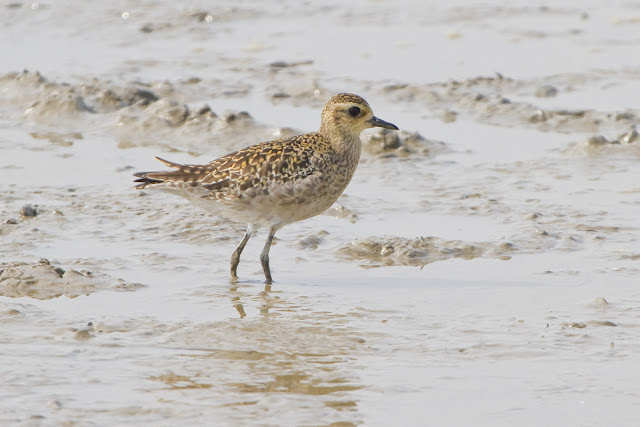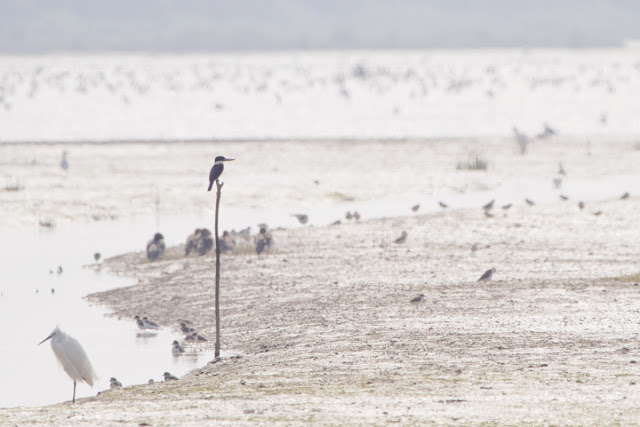Franklin's Gull - a Hong Kong mega rarity!
The past week had been exceptional in terms of birding. Rarities after rarities! It was like the heaven had opened up and great birds were descending upon us! It's at these times that you are reminded of the excitement birding brings, and also time to meet with old friends and acquaintances when everyone are attracted to the same places looking for the same birds!
I hurried off to Mai Po after the sermon at church. Rushing to get there before the tide reaches it's highest point. My mission for today was clear, to get the Franklin's Gull which I missed yesterday. I rushed straight into Deep Bay and met Benjamin at the bird hide, on the way getting close views of a Chinese Grosbeak. No Gulls to be found there except for Black-headed, Saunder's and Heuglin's Gulls after a quick scan with my scope, Benjamin did managed to spot a Long-billed Dowitcher however. There were numerous waders around, with many Pacific Golden Plover close to the hide, a Black-capped Kingfisher stood very still on one of the perches it frequented.
Chinese Grosbeak - handsome as always
Long-billed Dowitcher
Pacific Golden Plover
Black-capped Kingfisher at a distance
Seeing there weren't many Gulls to be found here, we moved along and headed to the HKBWS hide. On the way we encountered a huge tour and the guide told us the Gull was showing at the moment. We hurried over and sure enough quite a few birders were there, including Richard L. whom found the bird few days ago! We soon settled in and with their directions I soon had my scope locked onto the bird, it was however quite obscured by numerous birds blocking the view! For half the time we were only able to see it's head. It wasn't until much later that we got some better views of the whole bird.
The bird was miles away as the tide was much lower then yesterday's. But, I was happy to just catchup with this mega rarity. Franklin's Gull's is native to the New World, where it breeds in central Canada and the States and winters along the west coast of South America. Therefore, this individual was no doubt extremely off course to have turned up all the way in South East China! It probably was wondering at which point it had started heading south in the WRONG direction, I am sure it was still figuring out how come it had followed the oriental flyway instead, hence it could not really sleep much while we observed, jet-lagged perhaps? Here's a shot with John Chan's 500mm + 1.4x whom he kindly lend me for a few shots and a photo by my iPhone through the scope.
Franklin's Gull - sitting amongst the larger Black-headed Gulls
Franklin's Gull - a shot with my iPhone
The bird stood there and didn't really do much while we were there. I wonder if it was lost in translation? So I looked for other means of entertainment in the hide. I found the Greenshanks foraging near the front of the hide quite amusing, one individual caught a large Mudskipper at one point, trying it's best to gulp it down. I admired it's effort and courage, but to swallow what was much larger then it's head proofed to be a little too much for the little wader. It soon gave up, sparing the Mudskipper it's life, it was probably quite terrifying for the Mudskipper though...hence the facial expression on it's face.
Common Greenshank - with the Mudskipper
Just as we were about to leave the hide, the Gull flew and I managed a few distant inflight shots. It followed a few Black-headed Gulls and flew westwards. I wonder how much longer it will stay at Mai Po.
Franklin's Gull - inflight
We headed to hide #3 at scrape 16/17. People had been taking photographs of an Eurasian Bittern there for the past week or so, and that's a species I have yet to get any photographs of despite seeing them every year. The Bittern was hiding when we arrived, but an Eastern Marsh Harrier kept circling around obviously looking for an easy meal.
Eastern Marsh Harrier
It wasn't long before the Bittern finally showed, and what a sneaky bird it was, skulking through the tall grass hunting in the shallows. Seeing one at such close range make you realise just how big they are! It was very entertaining and everyone clicked away every time it revealed a little bit more of it's body. Even my 100-400mm managed some cracking photos, clearly indicating how close the bird was to the hide.
Eurasian Bittern - a top notch skulker with much charisma
I suddenly received a message that a Booted Warbler had been spotted near the tower hide, twitch on! We immediately packed our things and ran to the location to find a group of other birders coming down the other way. They had seen the bird earlier but had lost it in the reed bed. We waited and a brief playback was used but the bird did not respond. We waited and waited, until most other birders had left and the sun slowly sank. Suddenly, we found the warbler fluttering about in the reeds, a tiny plain reed warbler with whitish underparts and buff flanks, very short and pale supercilium. It was a shame that the bird was gone before I had time to pick up my camera, however others in the group managed a few shots of the bird and a quick review confirmed it's identity! Another phenomenal bird! This amazing weekend had gained me three Hong Kong ticks and two lifers. Along with numerous other great birds seen along the way will surely make this one of the most memorable.
Location of the Booted Warbler, the bird will be somewhere in there...





















































